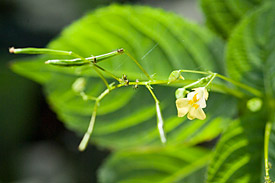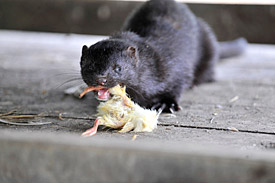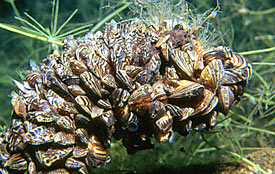Press release from June 16, 2010
Consequences of being rich: wealth and population are key drivers of invasive species in Europe
A new study of biological invasions in Europe found they were linked not so much to changes in climate or land cover, but to two dominant factors - more money and more people. Wealth and population density, along with an increase in international trade and commerce, were the forces most strongly associated with invasive species that can disrupt ecosystems and cause severe ecological or agricultural damage, scientists said.

The Small Balsam (Impatiens parviflora) is originally from Kashmir and Tajikistan. Meanwhile, the plant also spreads out in
Germany.
Photo: André Künzelmann/UFZ

The American Mink was introduced from North America for the fur farming industry. Meanwhile the European Mink (Mustela lutreola) is threatened by the American Mink through competition by means of direct aggression.
Photo: André Künzelmann/UFZ

The Zebra mussel (Dreissena polymorpha) is an invasive species in Europe with a high impact.
Photo: Dieter Florian, Leipzig
An international group of 26 researchers reported the new findings this week in Proceedings of the National Academy of Sciences of the United States of America (PNAS), a professional journal. The publication resulted from a three-year project DAISIE (Delivering Alien Invasive Inventory for Europe), funded by European Union within its 6th Framework Programme.
Dealing with these issues will be "pivotal for policy makers and future management," the researchers said, although no easy or inexpensive solutions exist, and many nations have been reluctant to take steps that might interfere with economic growth. "Invasive species are a continuing and extensive ecological crisis, and we are finding that human population and accumulated wealth are important drivers of this problem," said Petr Pyšek, professor of ecology with the Institute of Botany in Průhonice, Academy of Sciences of the Czech Republic, and with Charles University in Prague, the lead author of this study. "Regional patterns of species invasions are complex, and there is still unexplained variation likely due to local scale differences in several of the ecological factors, including climate," Pyšek said. "But invasive species are in large part an international trade issue, and we are the first to show that economic and demographic factors are key drivers across a range of taxa, more important than regional differences in geography and climate. Next to human population density, the closest correlation is to long-standing national wealth."
Human activities often related to trade, travel and transport, particularly in the past 50 years, have caused a surge in the number of introduced species, ranging from plants to fungi, insects, fish, birds, reptiles and mammals. While some species are innocuous, many displace native species and cause a range of ecosystem disruption. As a crossroads of international travel and trade, with both a high population and high income, Europe has experienced many invasive species. The study concluded that other possible factors, such as climate, geography or land cover, were less significant than population density and wealth, and that those secondary causes may have been overestimated in the past. This is because mechanisms of species invasion are often associated with international trade. Invasive species can contaminate imported products, stowaway in shipping containers, be brought to new regions as pets that subsequently escape, or even be deliberately released into the wild, as in the case of game animals and biological control agents.
In the new study, researchers were able to predict the number of alien species in Europe to a reasonably high degree simply by defining the level of wealth and the number of people. "The overwhelming effect of human factors, wealth and demography, found for several taxonomic groups translates to human activities responsible for enhancing biological invasions," researchers wrote in the study.
Solving this problem will not be easy, the study suggested. "However, identifying the specific mechanisms of invasion is the critical first step. Monitoring may need to be improved. Legislation to restrict or regulate certain imports will likely be needed, in addition to charging fees or tariffs that would help deal with invasive species when they occur. But the World Trade Organization and other international agreements have no effective mechanisms to address this concern," says Professor Phil Hulme, co-author of the study and the coordinator of the DAISIE project from Lincoln University, New Zealand. "And aside from good intentions, restrictions could be costly."
A major challenge will be to understand the specific economic factors leading to introductions so they can be effectively addressed while minimizing negative impacts on international trade. These factors are likely to differ among species. For example, minimizing releases of vertebrate species might require additional regulation of the pet trade, while a focus on transport infrastructures such as canals may help control introductions of alien invertebrates. "Nations do not have a good track record in forsaking future economic prosperity for environmental benefits," the study concluded. "Only if the true determinants are identified will it be possible to predict and manage alien species invasions adequately without adverse effects on other economic sectors."
Publication:
Pyšek P., Jarošík V., Hulme P.E., Kühn I., Wild J., Arianoutsou M., Bacher S., Chiron F., Didžiulis V., Essl F., Genovesi P., Gherardi F., Hejda M., Kark S., Lambdon P.W.,
Desprez-Loustau A.-M., Nentwig W., Pergl J., Poboljšaj K., Rabitsch W., Roques A., Roy D.B., Solarz W., Vilà M. & Winter M. (2010):
Disentangling the role of environmental and human pressures on biological invasions. - Proceedings of the National Academy of Sciences of the United States of America (PNAS), published
online early on 7 June 2010
www.pnas.org/cgi/doi/10.1073/pnas.1002314107
Further information
Prof. Petr Pyšek, Academy of Sciences of the Czech Republic, Průhonice / Praha
pysek@ibot.cas.cz
telephone +420 271015266
Prof. Petr Pyšek
Prof. Philip E. Hulme, The Bio-Protection Research Centre, Lincoln University, New Zealand
Philip.Hulme@lincoln.ac.nz
telephone (64) (3) 321 8317, fax (64) (3) 325 3864
Prof. Philip E. Hulme
Prof. Montserrat Vilà, Estación Biológica de Doñana, Sevilla, Spain
montse.vila@ebd.csic.es
telephone +34 954-232340 ext. 123
Prof. Montserrat Vilà
Prof. Wolfgang Nentwig, University of Bern, Switzerland
wolfgang.nentwig@iee.unibe.ch
telephone 0041-31-631-4520
Prof. Wolfgang Nentwig
Dr. Susan Shirley, Oregon State University, Corvallis, USA
susan.shirley@oregonstate.edu
telephone +1-541-737-6194
At the Helmholtz Centre for Environmental Research (UFZ), scientists research the causes and consequences of far-reaching environmental changes. They study water resources, biological diversity, the consequences of climate change and adaptation possibilities, environmental and biotechnologies, bioenergy, the behaviour of chemicals in the environment and their effect on health, as well as modelling and social science issues. Their guiding research principle is supporting the sustainable use of natural resources and helping to secure these basic requirements of life over the long term in the context of global change. The UFZ employs more than 900 people at its sites in Leipzig, Halle and Magdeburg. It is financed by the German government and by the states of Saxony and Saxony-Anhalt.
The Helmholtz Association helps solve major, pressing challenges facing society, science and the economy with top scientific achievements in six research areas: Energy, Earth and Environment, Health, Key Technologies, Structure of Matter, Transport and Space. With nearly 28,000 employees in 16 research centres and an annual budget of around EUR 2.8 billion, the Helmholtz Association is Germany’s largest scientific organisation. Its work follows in the tradition of the natural scientist Hermann von Helmholtz (1821-1894).
